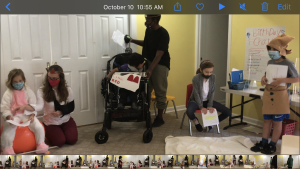 Our Augmentative Learning Program Study (ALPS) performed their first Readers’ Theater!
Our Augmentative Learning Program Study (ALPS) performed their first Readers’ Theater!
This was certainly a labor of love for our group, as the students were required to produce every part of this performance – from writing the script to making the costumes.
What I love about readers’ theater, or putting on plays with children in general is that it is a medium that naturally lends itself to differentiation. As I shared earlier, my hope for this group is to follow inclusion advocate Shelly Moore’s teaching is like bowling philosophy. If you focus on hitting the 7th and 10th pin instead of simply rolling the ball down the middle of the lane, you are more likely to knock down all the pins – or reach all the learners. When we only plan to teach the children in the middle – or to hit the middle pins – we are more likely to leave out the students that stand out on either side.
And so – our Little Red Hen unit was carefully planned to reach the learners on either side of the lane, knowing that this way we would meet everyone’s needs.
Our third graders wrote the play, using a variety of Little Red Hen books as models. They adapted the story to fit the needs of the group – allowing for AAC users to star in the show, writing in a non-speaking support buddy as a natural part of the play, and thinking through other access issues. They added their own third-grade twist to it, bringing in a T-Rex to steal all the brownies. None of these boring “who will help me?” storylines – they even wrote in a fight-scene between the T-Rex and Little Red.
Those who wanted to were able to memorize their lines, while others were able to practice repeating readings of their lines. Joey’s lines were on his AAC device
 (he did end up with almost the most lines), but a last minute switch was made to have him use a big-mac button with his brother’s voice recorded with the lines. Each child worked on their own goals during this – memorizing, speaking out, reading repeated lines, attending to cues, and monitoring social-cues for the right turn to speak.
(he did end up with almost the most lines), but a last minute switch was made to have him use a big-mac button with his brother’s voice recorded with the lines. Each child worked on their own goals during this – memorizing, speaking out, reading repeated lines, attending to cues, and monitoring social-cues for the right turn to speak.
The children even made their own costumes as well as baked the brownies (clever students realized that Little Red made brownies instead of bread then the cast could eat the brownies at the cast party.)
Projects like this one let us challenge each learner where they are while building community and a sense of ownership in our work. I’m looking forward to more projects like this, where each of our students is able to shine and grow while working together.


